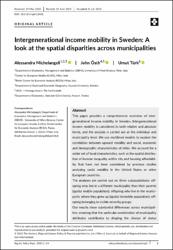Intergenerational income mobility in Sweden: A look at the spatial disparities across municipalities
Abstract
This paper provides a comprehensive overview of intergenerational income mobility in Sweden. Intergenerational income mobility is considered in both relative and absolute terms, and the analysis is carried out at the individual and municipality level. We use multilevel models to explore the correlation between upward mobility and social, economic and demographic characteristics of cities. We account for a wider set of local characteristics, such as the spatial distribution of income inequality within city and housing affordability that have not been considered by previous studies analysing social mobility in the United States or other European countries.
The analyses are carried out on three subpopulations: off-spring who live in a different municipality than their parents (spatial mobile population); offspring who live in the municipality where they grew up (spatial immobile population); off-spring belonging to visible minority groups.
Our results show substantial differences across municipalities, meaning that the particular combination of municipality attributes contributes to shaping the chance of status attainment among young generations. Highly mobile municipalities have more significant human capital, more residential segregation by income, more local levels of income inequality, and greater accessibility to jobs. The results indicate that dependence on parents' support and network for upward mobility is of less importance, and that spatial mobility (regardless of background) especially to larger urban areas is associated with upward mobility for the children.


















